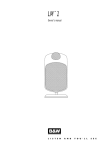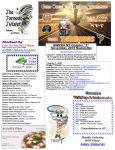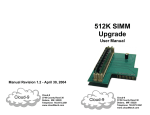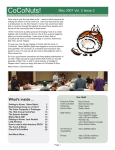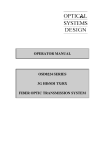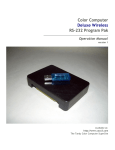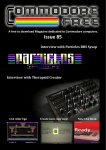Download the PDF of this issue - Retrogaming Times Monthly
Transcript
Retrogaming Times Monthly - Front Cover Printing Help Retrogaming Times Monthly #108 - May 2013 ■ Press Fire To Begin ■ The Retro Junkies - Kool-Aid Man For The Intellivision! ■ Retrogaming News ■ MAME Reviews - Fitter/Round-Up ■ Apple II Incider - Leisure Suit Larry/Softporn Adventure ■ More 64! - Seuck Competition 2013 ■ Sega vs. Nintendo - Des Gamer's Team ■ Des Gamer - Fanboyism, And The 16-Bit Console Wars Part 2: Graphics ■ CoCoLicious! - Chasing Sound On The CoCo 3 Reviewing Sound Chaser – a CoCo Music Player from Bill Pierce ■ NES'cade - Road Fighter ■ Caught On Film - Fix-It Felix, Jr. ■ The Pixelated Mage - Aero Fighters 2 ■ Game Over file:///C|/Users/Bryan/Documents/Websites/Retrogaming%20Times%20Website/magazine/rtm108/frontcover.html[5/1/2013 8:28:11 PM] Retrogaming Times Monthly - Press Fire To Begin Well folks, after years of waiting, we finally have a Kool-Aid Man review. I’ve always had an interest in any video game based off of Kool-Aid that I had to ask The Retro Junkies to write up a review for the game now that they have an Intellivision. I’ve never played this title, but have seen screen shots and thought it looked interesting. Therefore, for those out there that have not seen or heard of this one, check it out in this month’s “The Retro Junkies” column. Something I have noticed now that I have been in the classic gaming circle for about 15 years (hard to believe) is that the prices for my beloved TI-99/4A have been climbing as of late (the last 2-3 years). Recently, a cartridge of Q*Maze sold for over $600 on eBay, which is a rare TI game, but back around 2000 or so it would have probably sold for $40 tops. I have also noticed this price increase in common games, such as Parsec, things that you couldn’t give away on eBay back when I was starting out since they were common as dirt. Has anyone else noticed a similar upward trek in prices for other systems? I don’t know if it’s because everything’s getting older and therefore harder to find working items, which could be the case. When I got on the scene in 1998 I was lucky enough to get into the tail end of when people were cleaning out their attics and basements so supply was plentiful and everything was cheap. I have heard it said that once people reach the middle of their life that they try and buy things that they had in their childhood. Considering that the TI as well as other famous classic computers/consoles came out in the late 70s-early 80s, that would mean that someone who was roughly between 5-12 between 1977-1984 would have a revived interest in classic systems about 18-30 years later (when they are in their early-mid 30s). In terms of years, that would be 1995-2014. While we are still in that range, we are getting near the end of it, meaning that people who had the NES/SNES growing up should be making up the main core of middle aged gamers. I have to wonder if this price uptick is temporary or if we might see prices continue to rise for these early classic systems? It should be fun to watch. Who knows, maybe one day Parsec for the TI-99/4A will be considered Extremely Rare since many have turned to dust. And to think that I have a whole drawer full of them (20+)! file:///C|/Users/Bryan/Documents/Websites/Retrogaming%20Times%20Website/magazine/rtm108/101.html[5/1/2013 8:28:12 PM] Retrogaming Times Monthly - Retrogaming News New Freeware Amiga Game A UK game company, Blackjet has just released its new freeware Amiga game called Moebius Goatlizard. According to staff member Zach Nyne, it's "a distinctive platformer game unlike anything I've played before."Therefore, you might want to check it out if you're an Amiga fan. It's free, so who's complaining! Here's the story to the game: "Insatiable lust for all things cosmic brings Moebius to the world of Amiga where he must collect inter-galactic stuff to help feed his dirty collecting habit. Or somethign along those lines." CORGS-CON 2013 Saturday, May 25 10:00am - 6:00pm EDT (Columbus, OH) Greetings gamers! The Great Buckeye has finally come out of hibernation and is gearing up for CORGS-CON 2013. It is now 1 month away!!! It will be on 5.25.13 at Fort Rapids Water Park, here in the capitol city…same place as last year. We've expanded this year's show to all four ballrooms this time, and currently there are roughly 20 tables left. Contact G-Money (Gary C.) at 614-284-5831 to get your tables today. They will not last long! We are offering a few new things this year. First off, there will be a 'Beat the Wookie' Dance Competition at the top of every hour. If you can get a better score than the Wookie playing Dance Factory (PS2), you will earn a prize! As usual, there is free parking, and standard admission is only $2.00 The show will run from 10am to 6pm, with doors opening for vendor setup at 7am. However, this year we will also be offering an Early-Bird Special. Between 9am and 10am, you may enter early to get special deals and goodies. The Early-Bird Special admission is $5.00. SC3 / Arcade party Saturday, June 1, 6:00pm - 1:00am PDT (Santa Ana, CA) It's finally time for the first SC3 event of 2013! Our next Arcade Party will take place on Saturday, June 1, at The Last Arcade on the Planet, a private facility jam-packed with '80s arcade classics in Santa Ana. If you're familiar with the gaming scene in Orange County, you may already have heard of The Last Arcade. The owner, Juan, has hosted numerous parties and events there. This is the first time SC3 has been involved, but it's a perfect fit for us. The Last Arcade features over 50 classic cabinets (and 5 pinball machines) representing the best titles from the Golden Age of Arcades. SC3 is bringing our usual complement of classic home console games and maybe a cabinet or two of our own. It'll be another great evening of games, games and more games! file:///C|/Users/Bryan/Documents/Websites/Retrogaming%20Times%20Website/magazine/rtm108/102.html[5/1/2013 8:28:12 PM] Retrogaming Times Monthly - Retrogaming News Event Schedule The June 1st party opens at 6 p.m. and lasts until 1 a.m. Home consoles and the game trading area will be stationed outside, and will likely close an hour or so before the event ends. The arcade itself will remain open until 1 a.m. Tentatively-scheduled Attractions: Over 50 classic coin-ops (and a few pinballs) on free play! Multiple home consoles, games, & oddities Snacks and cold drinks to enjoy SC3-TV and other classic gaming video clips Game trading! BRING YOUR TRADEBAIT Food Schedule Drinks and some snacks will be available at this event, but entrees will not be provided. We are attempting to line up onsite food vendors, but have no commitments as of yet. We'll post updates as soon as we know more. There are also a number of restaurants (both fast food and fast casual) in the area. Donations Are Appreciated! With over 50 machines, electric bills are expected to be quite high. Your donations fund all SC3 events and are greatly appreciated. If all adult attendees chip in just $5, that should cover our expenses. Thank you! RSVP Today! The Last Arcade on the Planet is located at 1400 E. St. Andrew Place, Suite E, Santa Ana, CA 92705 If you want to attend, you must fill out this RSVP form. If your registration is accepted, you will be informed via email. Simple! If you would like to have your event featured in Retrogaming Times Monthly, just send an e-mail to Bryan Roppolo at [email protected] and he'll make sure to announce it in a future issue. file:///C|/Users/Bryan/Documents/Websites/Retrogaming%20Times%20Website/magazine/rtm108/102.html[5/1/2013 8:28:12 PM] Retrogaming Times Monthly - More 64! Seuck Competition 2013 The Shoot 'Em Up Construction Kit allowed Commodore 64 fans to create their own games, thanks to Sensible Software (the team responsible for Wizball and Parallax among others). Since its release many users have tried to create new and original games with the Kit. As a fan of the kit, I was happy to see all the new releases in this year's competition organised by Richard Bayliss. THE KIT Using a series of menus and utilities, an entire game can be drawn and created using the joystick. Sprites can be animated and turned into enemies, explosions, bullets and the player-controlled characters. The background is built up with characters, which are placed into 5x5 character blocks to quickly build up the map. This map can scroll vertically, be push-scrolled (moving up as the player reaches an upper boundary that can be defined) or shown as a series of timed single screens. The sound FX can be tweaked using a very easy interface similar to a mixing desk and the front end (including the character set used for text) redefined. Four different games were included to demonstrate the versatility of the Kit. THE UPGRADE Many people wanted a horizontally scrolling version of the Kit, and in 2008 programmer Jon Wells released Sideways SEUCK. This scrolled the screen from the left to the right, compared to the more common right to left. Jon has also created and enhanced SEUCK games using machine code, adding and changing features from music in the game to smart bombs and power-ups. THE COMPETITION Richard Bayliss has also been a fan of the Kit, and this year is the fourth competition he has run for creating new SEUCK games through his website. Part of the prize is that Richard will add enhancements including a tape loader and music to the winning entry. There have been some very original entries this year, and here they are (in the order they were submitted to the contest): THE DARK WITHIN By Pievspie/Rubberland Studio A familiar style to this vertically scrolling game, as you fight against enemies representing "fears and vices", to quote the instructions. Collect the bonus cassettes for extra points. file:///C|/Users/Bryan/Desktop/Articles/201.html[5/1/2013 8:57:17 PM] Retrogaming Times Monthly - More 64! DANTE'S DEPARTMENT STORE By Pievspie/Rubberland Studio Rubberland's second entry was done in Sideways SEUCK, and has the player fighting through a department store invaded by demons from another dimension. GOLD QUEST 5 (PLAYABLE DEMO) By Thorsten Schreck (Sledgie), Pingo, Camailleon, Stefan Egger The hero of the previous Gold Quest games, Sledgie, has been thrown into a cave so it is up to Dworina to rescue him. She throws axes to kill the enemy and picks up the gold for bonus points. (Other objects in the game were intended as power-ups and will be fully active in the final enhanced game). SHEER EARTH ATTACK By Gaetano Chiummo It is the year 2261 and a prophecy foretells the destruction of the Earth. Get into your spaceship, dodge asteroids and shoot the enemies before facing the huge end of level bosses. SPY RIDER By Alf Yngve Alf has created some clever games in the past, and his latest draws inspiration from Spy Hunter. Player 1 controls the car racing back to its hideout, but the unusual touch is that player 2 helps protect the car by shooting down the attacking helicopters. REALMS OF MIDGARD By Anthony Burns This game makes extensive use of high-resolution tiles (a clever trick that needs careful editing) to create the map-like backgrounds. The player's galleon must protect the city from attack, without destroying the farms that provide the resources to rebuild the city if it gets damaged. A separate end sequence can be watched with the combination revealed at the final level of the game. Retrogaming Times Monthly - More 64! ZOMBIE BRAIN EATERS By Andy Vaisey Here I must reveal a vested interest, as I helped playtest this entry. Horizontally scrolling like Operation Wolf, the player must gun down the hordes of zombies without being bitten. First aid kits help restore the player's life bar and there are four different environments to survive. AUFWAERTS (GOING UPWARDS) By Sonny Top (Bamse) The challenge here is to guide a balloon upwards through the hazardous skies, helped by a map that appears briefly at the start of each level. The two players have different abilities - player 1's large bubble cannot shoot, but moves faster than the smaller player 2 bubble that can shoot certain hazards. DODO' S DEEP DOO-DOO (80% VERSION) By Carl Mason Another game that gives you a map to help, this time as the levels scroll horizontally. The player controls the last of the dodos, escaping the traps left by Portuguese sailors and looking for somewhere to lay her eggs. SYNERGY By Alan Simek The player has escaped from the alien space station and must now destroy the cargo it carries as he escapes. The vertically scrolling backgrounds have great features, including the radar dish, and the sprites are highly detailed and well animated. In-game music adds to the atmosphere. AMAZON GOLD By Ryszard Nazarewski The year is 1933 and explorer Greg Troublynsky has possession of his late uncle's map to the secret Temple of Gold. The screen scrolls sideways as Greg avoids traps and the bombs dropped by passing aircraft, before entering the temple itself and liberating the gold. By the time this article is published, the winners should have been revealed. But they are all fun games to play and show the Kit can do more than some people expect. file:///C|/Users/Bryan/Desktop/Articles/201.html[5/1/2013 8:57:17 PM] Retrogaming Times Monthly - More 64! WEB RESOURCES http://www.tnd64.unikat.sk/Seuck_Compo_2013.html - the official website of the 2013 competition. Each games download includes the “all data” file (.I suffix) to load into SEUCK and examine how the game was made. http://www.seuckvault.co.uk - my personal SEUCK website, the SEUCK Vault hosts games created with the C64 and Amiga Kits, as well as tips and articles on how to make and enhance your own. If you have created any games with the Kit, get in touch. http://sourceforge.net/projects/vice-emu/ - VICE (the Versatile Commodore Emulator) is the easiest way to play the games on a variety of computer formats. Note that all the games were created with the PAL version of the Kit and should be played in that mode (Options > Video standard > PAL-G). file:///C|/Users/Bryan/Desktop/Articles/201.html[5/1/2013 8:57:17 PM] Retrogaming Times Monthly - Sega vs. Nintendo Throwdown Des Gamer's Team My Teams Nintendo Mario R.O.B Link Samus Fox Sega Sonic Ristar Shinobi Nights Red (Gunstar Heroes) Matchups 1) Sonic vs. Mario 2) Ristar vs R.O.B. 3) Shinobi vs Link and Samus. 4) Red and Nights vs Fox. The Battle Round 1: Sonic vs. Mario Mario and Sonic are standing across from each other. Mario has fire power. He also is standing by a TV set with invincibility inside. Sonic is standing next to two busted TVs that had just seconds ago contained the speed boost and a ring bonus. Also, right overhead Sonic is a question block containing a star. They're both standing, glaring at each other warily, simultaneously despising yet begrudgingly respecting each other. Mario has the fire power, Sonic has the speed. They are both guarding each other's chance at invincibility, virtually sealing the contest, should they get to it, and keep the other from theirs. The other's invincibility will do nothing for them. Redemption is with Sonic, for if he's hit, he has a chance to at least collect file:///C|/Users/Bryan/Desktop/Articles/202.html[5/1/2013 8:54:44 PM] Retrogaming Times Monthly - Sega vs. Nintendo Throwdown some of those rings back. However, time is with Mario, because unlike Sonic's speed bonus, his fire flower will not expire after a few seconds. So, naturally, the first move is Sonic's. Deviously, he hits the question block, releasing the star, sending it bounding off to the side of the two contestants, quickly getting away, towards a distant pit. Sonic also takes advantage of the millisecond of panicked disbelief on Mario's part, taking his focus off the blue blur streaking towards him. Mario doesn't have time to retaliate by stomping on the invincibility TV, instead, he launches a fireball at Sonic, but by the time it arrives at the destination, Sonic is gone. "Mama Mia" is Mario's frustrated internal monologue "I've-a got to aim-a where he'll-a be, not-a where he ees." So Mario fires three off in a hurry at different potential flight paths. He hits. Rings go flying, as Sonic is knocked back. Wasting no time, he scoops up 5 coins, before becoming another blur weaving his way at the plumber. Mario fires again, and hits again. Now's his only chance. If he's going to catch that star, he has to get a head start for it, while Sonic is busy "collecting himself." Mario fires another fireball behind him blindly, and is off as fast as his squat little legs will take him. Sonic, seeing what he's up to, narrowly missed and caught off guard by the stray fireball, makes full speed straight for the invincibility TV, which he busts open in a spiky ball with a drill sound. Now all scintillating, and aglow, he blasts off to catch up to the ponderous plumber who's fireballs won’t save him now, when the unthinkable happens....the music slows down! Caught off guard himself now for a millisecond, he falters, and goes down, but is now up to speed, and quickly narrowing the gap between himself and the fat Japanese negative Italian-American stereotype. A millisecond before Sonic comes into contact with Mario, Mario comes into contact with the star, which absorbs into him, and he starts to flash a million different colors himself. "No!" Sonic thinks to himself. They're even again. Will it be another standoff? His invincibility will wear off faster than Mario's will, then what? Lead Mario on a goose chase until his star wears off? Then what? He still has the fire flower, and Sonic only has two rings left. No. Sonic sees another option. Mario is dangerously close to that pit. So, mustering everything he has left, just as his invincibility is in its final sputters, he slams full speed into Mario, knocking him into the pit. But this close, this fast, Sonic is not able to stop either, and down they both go. Just before we hear the Mario death jingle and the loud "boong" of Sonic expiring, we hear a distant "kaplicka" followed by the telltale scattering of rings. Winner: Draw Round 2: Ristar vs R.O.B. Ristar is sneaking up on the ponderously plodding R.O.B. Just before he gets into range to grasp him, R.O.B. turns around. Black Johnny 5 eyes go red, and with a speed that Ristar thought was impossible, he finds himself in R.O.B.'s clutches. With a slam, he is stacked with all the other blocks and various other things the robot had been stacking. He appears to be out cold. As R.O.B. turns to grab another block with which to place on top of our little star friend, crushing him to death, Ristar jumps out, grabs R.O.B. and smashes him to the ground, breaking him in a million pieces, as the red Johnny 5 eyes flare up, then slowly fade back to black. Winner: Ristar Round 3: Shinobi vs Link and Samus There's a ninja dancing in the moon. Silhouetted against the glowing night orb. He's graceful. So very graceful! Every ninja dances. But ninjas do not dance for fun. They are not celebrating, they are not wooing a maiden, they are not commemorating anything. They are staying alive. The ninjas dance to evade lethal projections. Dodging death with every bob, weave, hop, and twirl. Joe Musashi dances tonight. An arrow here, a missile there. Moving aside twice for the boomerang, trees behind him being frozen by ice beams. Joe Musashi dances tonight like he dances every night. He's the shadow dancer...the Shinobi! Retrogaming Times Monthly - Sega vs. Nintendo Throwdown A small orb on the ground enters the moon approaching him, circling him, leaving small blinking objects on the ground. With a well-timed kick, the Shinobi punts the orb well into the trees, and well out of sight. Now the little objects are exploding. "Too close" thinks Joe as little bombs go off all about him. He does manage to avoid serious injury, but is still knocked to his back from the blow. Without missing a beat, a hook shot enters the moon, connects to Joe, and quickly yanks him from view. An armored figure runs across the moon in the direction Joe was yanked. Jump cut to a poorly lit grove in the woods. Joe is back on his feet after narrowly evading the arc of a glowing, pulsating sword. The master sword. Pulled from the rock by the boy who now wields it. With a fluid motion, Joe twirls out of the way, and in the same motion severs the hook shot with a sword of his own. The boy for his part barely raised his large patterned shield in time to stave off the throwing stars that seemed to come out of nowhere. With a ground round sweep kick, the boy is on his back with a shadow of a man looming over. However, this man is knocked back into the woods by a blast from an arm cannon. Where did the man go? Did he run? Neither Link nor Samus suspected he was done with them. Using her thermal visor, she spots him several feet off in the woods. She fires a missile that direction. But long before it reaches its target, he's moved out of the way. She loses him in the thermal glare from the missile explosion. A powerful kick from behind sends her sprawling face first to the ground. But before he can finish her off, A bright light is shining from the tip of a staff that Link is holding aloft. The ground shakes, and begins to fissure. Samus and Shinobi both are entirely engaged in evading the fissures. Eventually the ground seals back up, and Shinobi finds himself flanked by Samus and Link. He begins to dance again. Thinking they have him for sure now, they let loose with a barrage. And the ninja dances, sending sharp stars flying as he does which briefly slows the projectiles coming his way. "They're too smart to have them get each other with friendly fire." Joe thinks while his dance continues. He knows what he'll do. Link and Samus momentarily pause in awe as now there are two where there had been one before. Now it's a one-on-one dance. Not only are the dual Shinobi dancing, but Link and Samus are dancing as well. Dancing with the shadow dancer in the moon. Dancing the dance of death. Dancing for their lives. The dance continues in a balanced weave, until Joe's shadow Shinobi begins to fade away. Moreover, Samus having a free second from the fading warrior's departure goes into a ball, and drops a rapidly blinking object the size of her ball. This object is smoking, flashing a million colors, rumbling, and making an increasingly high pitched whine. "The Dance of Death" Joe thinks. "We die with honor." He thrusts his sword into the ground, grabs the pommel, kneels and turns to stone, which in just a second explodes in a huge jagged shatter. Link freezes, twirls in a circle, and blinks into non-existence. Samus is knocked backwards into the woods which, a second later are cleared out by the powerbomb she had dropped. Samus lay in the charred nothing...where are her signs of life? Musashi is dead. Link is dead. Could Samus be dead too? Long hours pass with no movement, no sign of life. Armor cracked, and badly damaged; scavengers will be able to get in and feast. Glowing eyes gather around the edge of the blasted landscape. They're waiting, just to be sure. No signs of life. No signs. But then the eyes grow wider, and quickly disappear as a large shadow spreads across the land. A large Metroid appears and hovers over Samus before thrusting down upon her. When the Metroid rises, so does Samus. Alive and well. She strokes the large Metroid, who then flies off. Samus summons her ship, boards, and heads off in the same general direction. She has faced countless great opponents, and challenges, and perils. And she has survived them all. But she'll never forget the ninja that danced in the moon. Winner: Samus file:///C|/Users/Bryan/Desktop/Articles/202.html[5/1/2013 8:54:44 PM] Retrogaming Times Monthly - Sega vs. Nintendo Throwdown Round four: Red and Nights vs Fox Nights is in trouble! Darting and flitting about to avoid heavy fire as he's hotly pursued by Fox McCloud in his fighter. He's running out of energy, and running out of time. Fox has plenty of both, and is getting madder and madder he hasn't caught him yet. Nights hears a shout beckoning him, and he veers off into a cleft in the rocks. Fox, thinking Nights is trapped circles overhead, occasionally firing into the rocks, hoping to ferret him out. Suddenly, Fox's ship is taking damage. From where?! All he sees is a little blue square of rapidly flashing laser light around his ship, as the obvious cause of the damage. "Blast! He's got some sort of weapon!" Fox exclaims, and fires a bomb down into the rocks. When that doesn't make the blue laser square go away, Fox flies away until the fire ceases. He then turns on long range scanners, to wait out his prey, and assess damages to his ship...it's not major. He doesn't have to wait long before his sensors alert him to movement below. He quickly pursues. He finds Nights, and another figure...riding on his back! The figure on Night's back is pointing a gun at Fox's ship, but nothing's coming out of it. Suddenly, he's taking damage again from the blue laser light square! He can't shake it! It follows him wherever he goes! Not even a barrel roll will get it off of him! His mission is clear! Take out that man with the gun! So he starts to spray fire, but Night's is able to dodge it. Fox can't sustain damage like this. So he veers off until he's out of range of that strange gun. He was still tracking them, though. Anticipating their course, he takes an alternate route, hoping to beat them there. It worked. As they neared, Fox rose up, firing straight at the man. He hits....Nights instead. Nights plummets towards a rock wall, and hits it with lethal force. Where is the man, though? Suddenly, Fox has his answer. The man is on the back of the ship, slicing it apart with what appears to be a laser sword coming out of his gun. Fox tries every maneuver he has at his disposal to shake the man, but he can't. In a desperate bid, Fox flips the ship upside down, and then flies it near to jagged rocks, hoping to scrape the guy off the roof of his ship. Seeing what he has in store, Red slices off a wing, then jumps off into the ocean. Fox's ship is too close to the rocks, and dips just enough at the loss of the wing to crash hard into them. As Fox's ship goes down in flames, Red spots Fox ejecting from the ship. So Red switches from flame/lighting back to chaser/lightning, and watches as the character in the parachute first flails about then slumps down upon exposure to the blue lightning square. Switching to lightning/force, he shoots the parachute, and watches the figure fall limply into the jagged rocks. Red then makes it to shore, and arranges for a pickup. Somewhere a small toad with a very "Ralph Wiggins" sounding voice is exclaiming into his ship intercom "Fox! Noooooo!" Winner: Red Overall One draw, one win for Nintendo, two wins for Sega. Sega wins! Go to top file:///C|/Users/Bryan/Desktop/Articles/202.html[5/1/2013 8:54:44 PM] Retrogaming Times Monthly - Des Gamer Fanboyism, And The 16-Bit Console Wars Part 2: Graphics Last month, I started a series on fanboyism, and the 16-bit console wars. Those who read it saw my "preamble ramble", where I dealt superficially with the subject of fanboyism, and set the stage for the hardware analysis which starts this month. You can see that introduction here [link]. While I don’t think I’m going to be dealing again with fanboyism directly for the remainder of the series, beyond this being a layman’s level analysis of the hardware and software, this will also be a running indictment of fanboyism implicitly, in that "here’s how it can be done without stooping to the level of the fanboy." So with that said, let’s jump right in. As promised, we’ll start with graphics: "The SNES has significantly more colors, 32,768 total / 256 simultaneous vs. a comparatively lame 512 / 64 on the Genesis. The SNES also has tremendously better RGB to composite conversion, so the picture is much, much sharper, and doesn’t suffer from the pervasive color bleeding, and color fringing that the Genesis suffers from. So it’s also much, much cleaner. In fact, with Genesis, you’ll have one of two bad video options depending upon which version you have. You will either have an even softer (read: blurrier) picture with "rainbowing" (most model 1s), or a somewhat less soft picture (still much softer than the SNES) and better black levels, but much worse color fringing and a vague grid pattern in everything. (most model 2s and the 32X)...it’s debatable which one is worse, and I’m not sure I’m prepared to weigh in on that. It’s kind of a "pick your poison" situation, unless you have a 32X, and then it doesn’t matter because the 32X output trumps the Genesis one (leaving you with the second of the two "poisons" – the worse color fringing and vague grid pattern.) As far as I know, there was not a meaningful difference in picture between the various models of the SNES. The SNES could do real transparencies, where the Genesis had to "fake them" using its bad RGB-to-Composite’s tendency to blur things. The SNES also has special "modes" for scaling and rotation, and whatnot, the most noteworthy being "mode 7". The Genesis doesn’t have such features. So in all these ways, advantage SNES! However, the Genesis could run in 320x244 or 256x244, where the SNES only ran in 256x244. Granted, the SNES theoretically could achieve a resolution of 512x448i per the spec sheet, but to the best of my knowledge, aside from a rogue menu screen or two, it never actually did this (however, Genesis did run in 448i once – Sonic 2 split screen...something its spec sheet didn’t even claim it could do). Most importantly, SNES never did this in an actual game play context, at least as far as I’m aware. If it ever did, it was never more than one or two. Initially I had believed this was due to CPU limitations, but I’ve had it explained to me that it had to do more with color management issues with the graphics hardware. Allegedly, the color count went way down, the colors that were there looked weird, and the picture became jumpy (plus it certainly wouldn’t have helped the already huffy, puffy CPU to run in full-res). In any case, theoretical figures aside, looking at what the systems actually did do in real life, we can reckon the SNES as having a resolution of 256x244, and the Genesis as having a resolution of 320x244, and that higher resolution really does make a difference! Advantage Genesis! file:///C|/Users/Bryan/Desktop/Articles/203.html[5/1/2013 8:54:43 PM] Retrogaming Times Monthly - Des Gamer Moreover, despite yet more theoretical, but unrealized figures on the SNES spec sheet, the Genesis also ran larger sprites, more detailed sprites, more simultaneous sprites, with better animation, and to top it all off, all of this happens at a faster nominal clip (by nominal clip, I mean average running speed of the game.) It’s been said that the SNES suffers from slowdown worse than the Genesis, and this most certainly is true to a degree (more often, more severe, and under lighter load), but I don’t think that it is true to the degree it’s often presented to be. It is true that the Genesis CPU is about twice as fast as the SNES CPU, but I don’t think the difference in processing power manifests itself primarily as slowdown differences (especially considering slowdown is also observed on the Genesis). Rather, I think the difference in horsepower is more apparent just in terms of simple nominal clip. The Genesis is much faster nominally. Advantage Genesis! Next, while it is undeniable that the inferior RGB-Composite on the Genesis is a weakness overall, there are actually some latent benefits that go along with it. For instance, with silvers, grays, whites, and very faded colors, the softer picture creates a powerful illusion of having an even greater resolution advantage over the SNES than it actually does. And on top of that, it does serve to create an illusion of depth in the picture that is missing on the SNES. It also allows programmers to trick us into thinking that there are more colors being used than there really are with tricks like dithering. This is also how they get the pseudo transparencies in, say, the waterfalls or transparent tubes in Sonic, small, straight vertical lines pressed together that the poor composite blurs into a pseudo-transparency...never would’ve worked with better RGB-to-Composite. Of course, the pseudo transparencies do come with the drawback of making whatever’s behind them become very blocky. My point is that in all these ways, the Genesis takes lemons and makes lemonade out of them, even carving a few advantages out of a big disadvantage. Besides, if the Genesis picture is often too soft and blurry, the SNES picture is often too sharp, and jaggy. Lastly, while the Genesis does not have anything directly like mode 7 (etc.), it did have something of a response to it: its ability to handle objects in space. It was a pseudo 3D of a totally different kind. Just a few examples of what I'm talking about are the "3D" bonus round in Sonic 3, the running man boss in Gunstar Heroes, and pretty much everything that happens in Vectorman. Just as F-Zero would’ve been impossible on the Genesis short of expensive in-cart booster chips, so would Vectorman have been unthinkable on the SNES without a lot of in-cart modifiers. And if you’ll allow me a little bit of purely bald conjecture, it seems to me that adding a mode 7 chip to a Genesis cart and porting F-Zero would be much easier than adding the chips that would get an SNES Vectorman port to run anywhere in the speed and smoothness league of the Genesis version (and it’d still be lower resolution). Now, whether this conjecture portion is right or not, in any case, advantage Genesis. Now, before we delve into the graphics and sound crucial topic of multiplatform games, first, just a quick word about how the multiplat scene back then differed from the multiplat scene on the current gen. These days, for better and/or worse, there is only one type of "multiplatform game": the kind where the different versions look, sound, and play as identical as the disparate hardware will allow. Examples would be the Call of Duty games. The PS3 and 360 versions (and now, the WiiU version with the latest installment) are as "clone" as could reasonably be had on the hardware. Back in the day, there was that same kind of multiplat (I.e. Monopoly, Spider-man/X-men: Arcade’s Revenge, NBA ‘96, Super Street Fighter II, Simpsons: Bart’s Nightmare, and Maximum Carnage.) I call this kind "straight multiplatform." However, back then, there was also another kind of multiplat where the different versions were completely different games, with the only common elements being the game’s name, major protagonists/antagonists, some common locales, and some of the same franchise-critical jingles. Examples of this kind are Aladdin, Jurassic Park, and Alien 3. A third kind existed, exemplified by games like Wolfchild, Earthworm Jim, and NBA JAM where they were essentially the same game - essentially "straight multiplatforms", but differed from straight multiplats in that where making the games as identical as possible was either the goal or the result of lazy programming in straight multiplats, properly utilizing each hardware platform was more the goal in this last type. For the purposes of our series, the first type, the straight multiplats will be our focus. The second kind, we’ll treat as console exclusives and not pay attention to at all, and the third kind will get a little attention, but not much, only as necessary to ferret out the nuances of the file:///C|/Users/Bryan/Desktop/Articles/203.html[5/1/2013 8:54:43 PM] Retrogaming Times Monthly - Des Gamer multiplatform situation. So, when it comes to straight multiplats, neither system is really pushed anywhere near their potential, but the Genesis usually suffers more. In most multiplatform games, the Genesis runs in SNES resolution (Genesis advantage forfeited), and with SNES sprites and animation (Genesis advantage forfeited), and with SNES quantity of simultaneous sprites (Genesis advantage forfeited.) Meanwhile, the SNES version still [usually] has more simultaneous colors (SNES advantage held), -always- has better RGB-Composite (SNES advantage held), and many times will feature some "mode x" trick (SNES advantage held). So, when it comes to straight multiplatform games, advantage: a resounding SNES (although it’s worth noting that this is so just as much through the Genesis condescending to SNES territory, where SNES will soundly beat it, as it is the SNES bringing its own strengths to the table...it’s also worth noting that in the ways in which the Genesis condescends, the SNES could never ascend.) There is, however, one very noteworthy category of multiplatform games which are an exception to the "advantage: SNES" rule, and that’s sports. Yes, in many cases, the SNES version still looks better in static screenshots because of the higher color count, better composite, and equal sprites, yet, one area where Genesis usually hangs onto its advantage is speed (Genesis advantage held). So these games almost always play faster and smoother on the Genesis. And since play is more important on sports games than graphics or sound, the Genesis version is usually considered the superior version. Sometimes the Genesis will also retain its superior animation (i.e. NBA JAM – which I think also runs in 320x244), and in those cases, even the better graphics thing is debatable. Advantage: Genesis. (In the case of NBA JAM specifically, I definitely favor the Genesis version, including the graphics.) So, with all this in mind, I don’t think when making objective comparisons, "better or worse" is a very helpful category. They’re each better at certain things, and each worse at others. Though you may want to tweak the exact language here, once again, I think a better way of framing it would be SNES: "crisper, cleaner, more colorful , mode x suite of effects" (or as I called it last month: "The Dazzler") vs. Genesis: "higher res, bigger, more plenteous sprites, faster clip, better animation" (or as I called it last month: "The Fast and the Furious.") Objectively, neither category is inherently superior. In fact, I’ll go on record right now and say that I objectively consider them a tie. Not in that they’re the same...far from it, but in that their objective pros and cons, when put on the metaphorical scales weigh out to be equal. However, one thing this distinction does do for us is it lends itself very nicely to subjective preference differences. For me personally, concerning the graphics on a purely subjective level: In my original rough draft of this series, I said the jury was still out. However, I think since that time, I’ve finally become comfortable in picking a side with some measure of definitiveness. I’m finding myself favoring the Genesis. Why? It just seems that I’m having an increasingly easier time looking past the color fringing, soft picture from the bad composite, and lower color count in the Genesis, in order to bask in the higher resolution, greater image depth, larger, more detailed sprites, and better/faster animation. While at the same time, it seems like I’m having an increasingly more difficult time looking past the jaggy, low-res, less detailed, and more wooden characters of the SNES in order to get my dose of the crisper, more colorful cleanness and mode x goodies that it lavishes in abundance. They’re both great in their own way, and for different reasons, but more and more, I find myself leaning the Sega way...and at long last, that impression finally comes complete with the slam of the gavel. So, that’s graphics, SNES vs. Genesis. Objectively, I’m calling them a tie. Subjectively, I’m finally able to declare a preference for the Genesis. Next month, we’ll take a look at the sound. See you then! file:///C|/Users/Bryan/Desktop/Articles/203.html[5/1/2013 8:54:43 PM] Retrogaming Times Monthly - CoCoLicious! Chasing Sound On The CoCo 3 Reviewing Sound Chaser – a CoCo Music Player from Bill Pierce Until recently, I had never given much thought to the number of music formats in use on the Color Computer. If I wanted to hear the CoCo play music, I’d load up one of the disks with some music and execute the BIN file or one of the applications that plays music and have at it. Then, in 2010 while writing a review for HDB-DOS/DriveWire 3, I became somewhat aware of the number of different music file formats for the CoCo. When using RS-DOS, there are a number of audio formats – Musica, Lyra, Orchestra 90 (not to mention other hardware audio accessories) to name just a few, and they have their own players and editors. In OS-9/NitrOS-9 there was Ultimuse III and maybe a few others – I simply do not know as I am not really that familiar with the OS-9 based operating systemsor the programs available to it – please consider that a disclaimer. My knowledge of NitrOS-9/OS-9 is incomplete, which is a polite way of stating the truth… This leads us to the subject of my review – SoundChaser. SoundChaser is the progeny of Bill Pierce, a long time CoCo user and musician, as well as an accomplished CoCo programmer, as we’ll discover shortly. If you do not know Bill, take a trip to his website, https://sites.google.com/site/dabarnstudio/ to see his projects and listen to some of his performances, along with CoCo accompaniment – very good stuff. Bill saw a need for a multi-format music player for the CoCo3, and it was certainly a legitimate need. There are a number of music/MIDI file formats for the CoCo, and no one player plays them all; or most of them for that matter. To fix this problem, Bill set out to create a NitrOS-9 application that was capable of playing quite a number of file formats, and thus far has succeeded brilliantly – I say thus far because it’s not quite finished – more on that later. Now, I must admit that a lot of trepidation set in when I was asked to review SoundChaser. As I said in the second paragraph, I have not used OS-9/NitrOS-9 much at all. Bill was very gracious in working with me and providing tips. While I do have a real CoCo3, with DriveWire 4, I decided to use MESS to work thru the very adequate user manual provided with the SoundChaser disks. My goal was to get the hang of using SoundChaser, from installation to playing music, before attempting to use it on my CoCo3 with DriveWire 4. Above I alluded to the factthat Sound Chaser works in tandem with DriveWire 4.This allowsthe CoCo3 to use your PC’s MIDI hardware to play back the sound files. DriveWire 4 has made this feat very painlessby allowing your CoCo3 full use of the MIDI capabilities on your PC, and SoundChaser has taken full advantage with its ability to play a plethora of CoCo3 sound files. In fact, SoundChaser allows you to view up to 500 songs, and with its playlist features, you can play music uninterrupted for hours at a time. Below are a series of images showing the different menus and features available to you thru SoundChaser: file:///C|/Users/Bryan/Desktop/Articles/204.html[5/1/2013 8:54:42 PM] Retrogaming Times Monthly - CoCoLicious! SoundChaser screen upon loading As you can see from the included screen shots, the GUI Bill Pierce has created is clean and very functional. Notice that when you highlight a song, at the bottom of the screen SoundChaser provides you with some details of the file: song title, file type and audio output method. SoundChaser File Menu The File Menu is accessed by pressing ‘F’ on the CoCo keyboard and provides several options including: Return to Main Menu Change Music Dir Save Default Options Dir Non Music Create OS9 Shell The Menu options are pretty self-explanitory, and the manual Bill provides should answer any questions you might have. file:///C|/Users/Bryan/Desktop/Articles/204.html[5/1/2013 8:54:42 PM] Retrogaming Times Monthly - CoCoLicious! SoundChaser Options Menu The Options Menu is accessed by pressing ‘O’ on the CoCo keyboard and provides the following choices: Return to Main Menu Set MIDI Out Drv Set Sound Output Set Ultimuse Opts Set Lyra Options File Format Opts Again, viewing the Sound Chaser manual should answer any questions you might have, but, most choices appeared to be very self-explanatory. Sound Chaser Search Function So, what do you do when you have a huge list of songs and you’re trying to find only one? Fortunately Bill built in a robust search function for Sound Chaser users, accessible by pressing the ‘S’ key from the main menu. If you’re taking advantage of a VHD or storing all of your music on a SuperIDE or other mass storage option for the CoCo3, this will be a very welcomed feature. Admittedly, I didn’t NEED to use the search function. However, I at least wanted to test the feature – bottom line is that the search feature is present, and when needed, it does its job very nicely. file:///C|/Users/Bryan/Desktop/Articles/204.html[5/1/2013 8:54:42 PM] Retrogaming Times Monthly - CoCoLicious! Sound Chaser selected music highlighted in blue Song selection is accomplished by highlighting them using the arrow keys, and then pressing the ‘Enter’ button. When doing this, the song title turns blue on SoundChaser’s GUI to indicate the song has been selected. Highlighting the same title and pressing ‘Enter’ again will deselect the song. This process is very intuitive and easy – the effort that Bill put into Sound Chaser is evident everywhere, as it is very easy to use and takes away all the headaches involved in playing multiple music formats from one centralized application. Sound Chaser provides the following abilities from one application: Plays Lyra, Musica, Midi &Ultimuse files (more file types to be added later) Plays all files types from a centralized application Build play lists from a scrolling selection screen of up to 500 songs In theory, the play list could consist of up to 500 songs Play lists consist of multiple files types SoundChaser Play List Menu In the images above, I have selected a number of songs (Highlight the song & press ‘Enter’), then pressed ‘L’ to view/edit the Play List. The Play List appears in the middle of the screen, and you can edit the list and play the files using the selections in the menu.The whole process is very intuitive, and reflects the time and effort Bill has put into Sound Chaser. Having written a lot about the GUI and features, I should probably say something about the installation process. Sadly, I fought with it at first. While trying to use VCC as my emulator of choice, I had all kinds of problems. Then I switched to MESS; while I was able to get Sound Chaser working under MESS, I still had to manually copy the files per the file:///C|/Users/Bryan/Desktop/Articles/204.html[5/1/2013 8:54:42 PM] Retrogaming Times Monthly - CoCoLicious! instructions in the manual. Once I switched to a real CoCo3 with DriveWire 4, there were no problems at all. The install script Bill has created worked flawlessly every time on the real hardware. What should you take from this? In all seriousness, it’s this: If I can set Sound Chaser up and make it run, so can you!! While considering this review, I was intimidated by the aspect of not having any real experience with NitrOS-9. Experience isn’t really needed. If you can read and follow the directions in the user manual, you’ll be fine. From my experience in dealing with Bill, if you have any problems I’m sure he’ll do everything in his power to assist you. Sound Chaser has done everything Bill said it would – and he has more options planned for the future. If you’re a fan of CoCo music, you cannot go wrong using Sound Chaser as your player of choice. The ease of set up and use, versatility, and overall quality display just how much effort Bill Pierce has put into Sound Chaser. We, the CoCo Users, are the beneficiaries of his work. I wholeheartedly give Sound Chaser (and Bill) two very enthusiastic thumbs up. If I had a third thumb, I give it too! file:///C|/Users/Bryan/Desktop/Articles/204.html[5/1/2013 8:54:42 PM] Retrogaming Times Monthly - The Retro Junkies Kool-Aid Man For The Intellivision! 1983. While Mark Hamill was saving the galaxy from the Empire’s evil clutches, while Michael Keaton became a stay-at-home mom and Chevy Chase took a family vacation to Walley World, The Police were watching our every step—even when Stevie Nicks told us to stand back! In 1983, pop culture was buzzing with iconic films and music that would define an entire decade. On the other hand, 1983 would also signify the plummet of the video game industry as we once knew it. Many video game historians speculate the catalyst for the video game crash: oversaturation of consoles and games, monumental developing blunders, the superiority of personal computers, etc. While the gaming industry was in the doldrums, there were still quality games being developed in 1983. Arcade treasures like Mario Bros., Spy Hunter and Dragon’s Lair along with home console gems like Intellivision’s World Series Baseball and Manic Miner for the ZX Spectrum were highly acclaimed. However, would General Foods—of all corporations— sponsor a game that would reach the same level of success of its predecessors in 1983? …Is this a long-winded prelude to a pop culture retrospective and video game review based on America’s delicious, albeit, creepy and carelessly destructive beverage mascot? In the words of KoolAid Man himself: “OH, YEAH!” Kool Beginings Kool-Aid Man. Is he a man, a myth, a legend, or all three? Kool-Aid Man was an icon of non-soda soft drinks for kids in the 70s, 80s, and part of the 90s. His trade mark ability to solve any situation with a pitcher and glass of Kool-Aid (and his other ability to destroy ANY barrier in his way) helped hydrate children everywhere! Kool-Aid Man had humble beginnings as the mascot for Kool-Aid brand drink mix. He is credited for being created by art director Marvin Plotts in 1954. However, Kool-Aid Man really didn’t become popular until the 1970s when he started starring in his own commercials. These commercials would usually consist of children doing some activity and claiming they were thirsty. When the words “HEY, KOOL-AID!” were shouted, the 6-foot tall pitcher of cherry Kool-Aid would appear and save the day! Kool-Aid Man would burst through walls or fences and give his trademark battle cry of “OH, YEAH!” Thanks to these commercials, Kool-Aid Man would star in not only video games, but his own comic book series, too! Kool-Aid Man was retired in the mid-90s, but you can’t keep a good pitcher of Kool-Aid down. Kool-Aid has recently brought him out of retirement to hydrate a new generation of children and adults alike. Kool-Aid Man for the Intellivision was released in 1983 by Mattel Electronics. Moreover, Kool-Aid Man was released on the Atari 2600 in the same year—which was an entirely different game that we’ll be sure to review someday! In the early 80s, almost everyone had a video game featuring a mascot or company name (We’re looking at you Chase the Chuck Wagon by Purina Dog Food!). With games on the market showcasing company mascots as heroes, Kool-Aid Man seemed like a no-brainer for a video game—he already has super strengths, i.e. breaking down walls and a sweet mission to stamp out thirst! In fact, it was so well-received that, had the video game crash of 1983 not happened, a sequel by the name of Kool-Aid Man II would have been released! file:///C|/Users/Bryan/Desktop/Articles/301.html[5/1/2013 8:54:42 PM] Retrogaming Times Monthly - The Retro Junkies …We can only hope that there’s a prototype of Kool-Aid Man II out there waiting to be discovered! The Raspberry Run-Down Publisher: Mattel Electronics, Inc. Developer: Mattel Electronics, Inc. Released: 1983 Platform: Mattel Intellivision Genre: Action/Side-Scrolling The Slammin’ Strawberry Story Kool-Aid Man for the Intellivision. While we’d try to explain this story in our own words, we believe the writers at Mattel Electronics hit the nail on the head: “Two children are trapped in a haunted house. A pair of insatiable THIRSTIES roam around trying to catch them! Help the children avoid the dangerous THIRTIES and collect all the makings for a batch of KOOL-AID® soft drink mix. Hooray! KOOL-AID MAN™ comes to the rescue! From then on—the THIRSTIES, plus PHANTOM FLAVORS get chased by KOOL-AID MAN™!” What can we say? Mattel has a way with words! The Great Blueberry Gameplay Kool-Aid Man has a variety of gameplay options. The Intellivision port features 13 skill levels—including a beginner’s level for unskilled gamers like us! When placing the Kool-Aid Man overlays on the Intellivision controller, numbers one, two and three represent the speed in which the children move and the time they have to make Kool-Aid before the evil Thirsties get them! The slowest option (button three) is highly recommended, as this is a very challenging game. By moving the joystick back and forth, you control two children who pitter-patter through longest house in the entire world! It took literally 43 seconds for us to get from one side of the house to other—which begs the question: why are these kids in a haunted house, anyway? And why is making Kool-Aid their first prerogative in a house full of ghosts? As you control the children through the house, it’s crucial to avoid the Thirsties as they attack in diagonal directions. If they come within three or four steps of the children, daunting music ensues in Jaws attack at this point is inevitable—one of the children will be attacked and let out a bloodcurdling scream! And for Intellivision standards, this scream is extremely creepy! From this point, the child that has been attacked is immobilized. The player has to continue with the other child in search of the ingredients to make Kool-Aid. However, there’s something that truly disturbs us. Here’s a direct quote from the official Kool-Aid Manual: “If a Thirstie catches one child twice—that’s it!” ...That’s…it? Isn’t this supposed to be a kid’s game? While trying to avoid the relentless barrage of Thirsties, the children have to wander throughout the house in search of three items: sugar, a pitcher, and a packet of Kool-Aid. Once the children collect the makings for Kool-Aid, Kool-Aid Man himself busts through the basement wall with reckless abandon! Players then control Kool-Aid Man as he catches the Phantom Flavors that are released and the menacing Thirsties in order to win points. This challenge progresses for 13 levels in total—with each new level including new layouts. Graphically, Kool-Aid Man for the Intellivision is sweet! (No pun intended!) The Phantom Flavors colors are representative to their flavors, the Thirsties actually look similar to the box art, and even big Kool-Aid Man himself looks great and easily recognizable! One gripe we have with the game is that the controls can be a bit sluggish. There have been countless times where a Thirstie has come near us and we were unable to get away due to such stiff controls. Moreover, the fact that once a child is paralyzed by a Thirstie, he or she can never be revived seems to make the game file:///C|/Users/Bryan/Desktop/Articles/301.html[5/1/2013 8:54:42 PM] Retrogaming Times Monthly - The Retro Junkies less interesting. Rob and Landon’s Famous Last Words So, in 1983, was Kool-Aid Man for the Mattel Intellivision a video game diamond in the rough? We think so. Kool-Aid Man is a solid game with a few very minor flaws. General Foods had the right idea by capitalizing on a pop culture icon like Kool-Aid Man, and if it hadn’t been for the infamous video game market crash, who knows? We could have seen a long line of Kool-Aid Man sequels on a variety of consoles! Just imagine: Kool-Aid Man busting through a basement wall in HD! …General Foods…make it happen! We give Kool-Aid Man for the Intellivision 7 Thirsties out of 10! OH YEAH!! Rob Luther and Landon Long www.facebook.com/retrogamingjunkies Image Credits: 1978 Commercial image from https://en.wikipedia.org/wiki/File:Kool-Aid_Man_breaking_wall_1978.jpg Go to top file:///C|/Users/Bryan/Desktop/Articles/301.html[5/1/2013 8:54:42 PM] Retrogaming Times Monthly - MAME Reviews Fitter/Round-Up You're a game designer in 1981. Your boss, obsessed with cashing in on fads of the moment, orders you to write a program combining Pac-Man and a Rubick's Cube. Envision the results (besides killing your boss, that is). Now compare your concept to Fitter, also known as Round-Up, a coin-op that shockingly was a nonentity in arcades despite its trendy elements. I'm guessing most of the ideas aren't any worse, since it was a rather questionable copulation to begin with. Pac-Man's had some strange trysts (although it's unknown if Fitter/Roundup was a post-honeymoon affair or just an engagement dalliance since Ms. Pac-Man became official the same year) and some have been more successful than one might expect. His same-sex coupling with Hangman resulted in the maddeningly addictive computer game Maniac. A recent one-nighter with Qix begat a rather fun-coffee-break Flash game Pacxon (and if wocka-wocka noises are a problem at the office, try the Pac-meetsZork text adventure Pac-Txt). On the other hand, his dalliance with pinball produced the bastard child Baby Pac-Man, his ill-matched relationship with elitist academia gave us Professor Pac-Man and his occasional spankings from Mario were generally a pain in the ass for all of us. Fitter/Round-Up leans more toward the latter group, but it's not so much a sex scandal as it is a bad date where the other person's constant prattle is incomprehensible. And if you're among the exceedingly few who manage to decipher it, you'll discover it's exceedingly shallow and repetitive. The goal is to avoid baddies and eat small red creatures that turn your character (who resembles an egg on its side wearing a top hat) the same color. Once you've consumed a red creature you navigate to a 3X3 grid of white dots at the center of the screen. Entering through an open path "pushes" a row or column of dots, turning the newly appearing dot red. You turn white as you emerge from the other side and then begin the process anew. Understand the concept? If not, go back and read the paragraph again, because that's as simple as I can make the fundaments. Some readers may think it's simple enough, but a healthy percentage of the few people who played the game back then couldn't grasp what it was all about. As with most games, there's a number of complicating factors. There's actually three types of "nice fellows" (the game's description of them) running around the maze that are safe to touch and affect your character. There's red and white Knights, which turn your character the corresponding color. Obviously you want to avoid the white Knights, but they do have a pesky tendency to get in the way when you're trying to reach the center while red. Most handy of all is the occasional King Rompus, which turns your character and all knights on the screen red, as well as temporarily paralyzing all of the enemies. file:///C|/Users/Bryan/Desktop/Articles/302.html[5/1/2013 9:58:50 PM] Retrogaming Times Monthly - MAME Reviews Entering the center grid isn't quite as simple as you'd like since there are barriers blocking some openings and they change position after each visit. It's also vital to make sure there's no enemies close to the opposite side since it takes a moment for your character to "warp" into position. As for the "bad fellows," there's two types: the "Boss Monster" and three of his cohorts (think of them as largely clueless Pac-Man ghosts) and tiny yellow "Slave Monsters" that get released occasionally instead of new "nice fellows." It turns out the release of creatures good and bad is largely dependent on the player – and this is either the game's saving grace or fatal flaw. Entering one of the two sets of tunnels releases either the rightmost or leftmost (depending on your direction) from a queue of creatures in a walled-off area at the top of the screen. Intentionally or not, it also means a skilled player can do a predictable release of characters until a King Rompus appears, then follow a similarly predictable set of movements to capture it and enter the center grid. While this means you might be able to play forever, it's worth asking if you really want to because it will take forever to get through each maze. There is a time limit, but it's so long it's unlikely to be factor. As a side note, it should be noted this is a disastrous situation for arcade operators as well. I believe it was Williams Electronics that said the optimal length of a game for maximum profit while not making players feel ripped off was about two minutes and 20 seconds. Even novices can stumble about in Fitter/Round-Up for quite a bit longer than that. If you complete a wave by turning all of the center dots red, there' s bonus stage with an "electronics cube" (a Rubik's Cube, except you're only trying to solve one side). The challenge is to match a pattern displayed underneath the cube, using the joystick to maneuver around the perimeter and the fire button to rotate. If successful you receive bonus points and another pattern to match as long as time remains. The cube starts at a 3X3 configuration, but becomes a more complicated 4X4 grid with higher bonus points after a couple of patterns are solved. I found it a lot more fun than the maze stages, but seriously – this is something arcade jockeys are going to go for? DIP switch options are fairly standard, with two to five starting lives, a bonus life at 10,000 or 30,000 points, and having monsters "wake up" (a.k.a. enter the maze) fast or slow. As someone who appreciates a little intellectual challenge with his dodging and fragging – hell, I'm still playing text adventures – I can see the allure of a Pac-Man game where brainpower beyond "eat all the dots" to complete a maze is required. But not only does Fitter/Round-Up feel like a crass marketing-to-the-masses exercise, its design is so flawed it has less chance of pop culture appeal than classic Greek theater. Still, this is the part of the review where a constructively-minded writer strives to come up with a "this game might appeal to (insert stereotype here)" closing so at least some readers don't feel like they've completely wasted their time. I'm going to nominate coinop completists (the game has a rarity rating of two out of 100 at The Killer List of Video Games) and nerds (not the same as geeks) who don't mind being manipulated by marketing department morons. Plus any former hackers at Taito (the original developer of Fitter) or Amenip/Centuri (which distributed it in the U.S. as Round-Up) who want to revisit their efforts and flame me afterward. FINAL VERDICT: THUMBS DOWN! Go to top file:///C|/Users/Bryan/Desktop/Articles/302.html[5/1/2013 9:58:50 PM] Retrogaming Times Monthly - Apple II Incider Leisure Suit Larry/Softporn Adventure It's a bit of a stressful time these things. I have some family things I have to deal with and "free time" is a little limited than it used to be. Any free time I do have is usually spent exercising or just chilling out. I haven't played too many retro games lately. However, there was a game that I wanted to review several months ago. The game was called Leisure Suit Larry. The game was published by Sierra during the late 1980's into the mid 1990's for many machines including the Apple II. I actually never had the game but did read reviews and may have played the game sparingly at stores. I honestly have very little memories of the game and wanted to give it a spin. Alas, the version on the Virtual Apple site doesn't seem to be working. As such, I can't write a review of the game for now. I did want to point out the Leisure Suit Larry has it's origins in a text adventure game called Softporn Adventure. The game was published by On-Line Systems, an earlier incarnation of Sierra. Softporn Adventure is on the Virtual Apple site and I gave the game a short spin. Alas, I didn't know the commands available for the game so I gave in and found a walkthrough. Thus, I can't really speak to the game experience. I can imagine that as with any text adventure, there's not a lot to discuss. I will add that I had a copy of Softporn Adventure as a kid. I'm not entirely sure how I ended up with it, but I saw it on a disk. As I wasn't much of a text adventure fan, I don't believe I got very far with the game at all. Now that I am an adult, I can look at Softporn Adventure and Leisure Suit Larry in better context. Too bad I can't get Leisure Suit Larry running but I'll do my best for an future issue. Go to top file:///C|/Users/Bryan/Desktop/Articles/303.html[5/1/2013 8:54:42 PM] Retrogaming Times Monthly - NES'cade Road Fighter For readers that have been following NES'cade for a while it should be no secret that some of my all-time favorite arcade games fall into what is commonly referred to as the "Konami Classic" hardware category. This is includes titles such as Pooyan, Circus Charlie, Scramble, Roc'n Rope, Jungler, Gyruss and a bunch more Konami games from the 1980's that ran on similar hardware featuring a similar look and style. Quite a few of these had home releases on the Famicom but unfortunately never materialized on the NES. Road Fighter is one such game and a title that tends to be forgotten even among those who fondly enjoy the classic Konami lineup. For a game released in 1984 it may look like a simple vertically scrolling driving game. However if one looks a little deeper then it becomes apparent that Road Fighter takes a little from every vertical driving game that came before it, adds new features, a bright and vibrant color scheme, and most incredible of all: driving controls with a joystick that actually work superbly. The game is about more than just simply driving to the end of a stage however. This is a multiple section rally race encompassing six stages. As you drive, your car consumes fuel and if you crash then even more fuel is expended to get you going again. Once the tank is empty the game is over. While completing each stage will keep the game going, it isn't the only objective, this is a race after all. At the start of the first stage of a race, when the start lights go out and your engine is fired, your car begins last in a field of forty cars. These are your rivals and you will spend the six stages of a race running them down and gaining positions. As this is a cross country rally there is plenty of non-race traffic to contend with, each of which will pose a different challenge. Yellow cars are slow moving and act as general traffic, holding their lines and slowly driving along. Red sports cars are slow moving as well but tend to swerve back and forth as they are approached. The yellow variety of sports car also moves slow and tends to change lanes but usually only one lane at most. The olive colored Le Mans prototype style cars are your rivals, passing them will move you up one position in the race standings. They are fast moving and tend to hold their lines but they will negotiate traffic A basic strategy of Road Fighter is to tail the Le Mans cars as they tend to have an unobstructed path, then make the pass when it's clear to get around. Other cars that show up based upon what stage is being driven through are muscle cars, convertibles, blue Le Mans cars and others that all act as general traffic, replicating the characteristics of other classes of traffic cars. From time to time trucks will also appear on the roadway including the dreaded green trucks that move extremely slow and are easy to collide with. An even bigger threat are blue and silver box trucks that move at mid to high speed, dropping barrels out of their trailers as they drive along. Finally, rainbow colored fuel cars appear from time to time and with them exists the only way to replenish your fuel supply mid-stage. Fuel cars move slow, mirroring the characteristics of standard yellow cars. Running into one will replenish some fuel but if a fuel car scrolls off the screen it then disappears. As is expected, negotiating traffic and keeping the accelerator down is how to complete a stage. Crashing into a truck will destroy your car instantly, however brushing against another car will put your car into a slide which can grow into a spin. Here lies the core game mechanic of Road Fighter and also what makes the game unique. The severity of a spin is based on speed and horizontal travel. Learning how and when to slow down and counter steer into slides, skids and spins is the key to success in the game. s in real life, turning into the skid will begin to alleviate the problem but severe spins will require reduction of acceleration as well as proper counter steering. It isn't uncommon to bounce around against multiple traffic cars in the event of a slide, especially when the road narrows or traffic thickens. You either learn how to anticipate what your car needs to get straightened out again or you crash and loose precious fuel. Oil slicks on the road surface can send your car into an abrupt and high velocity spin if driven over at the wrong time, making avoiding them and important part of reaching the end of a stage. Water puddles simply slow down your car and are more of an inconvenience than anything else. file:///C|/Users/Bryan/Desktop/Articles/304.html[5/1/2013 8:54:41 PM] Retrogaming Times Monthly - NES'cade It seems as if Road Fighter would be a relatively simple game to convert to home hardware since, enjoyable as it is, there really isn't anything technically amazing about the presentation. Control moves to the Famicom fine with left and right on the directional pad moving the car left and right as in the arcade. The B button is used for low gear acceleration while the A button is used for high gear acceleration, again, same as it was in the arcade. The game plays well, although it feels as if the whole game has been slowed down to compensate for the shorter vertical distance since the arcade original used a vertical display. The problems with Road Fighter on the Famicom have to do with simply how much of the original game was removed from the home release. Arcade Road Fighter is a race, everything about it is built around it being a rally race against 39 other cars. The status area to the right of the screen shows your rank among those 39 other cars, your time for the stage you're currently racing through, the amount of cars you've passed in the stage, your speed, a meter for RPM, a meter for fuel, and the total distance covered in the entire race. At the end of each stage a bonus is awarded for each car that you passed and your cumulative running time up to the completed stage, ranking against other cumulative times up to that point, and average speed are all displayed as a map screen shows your car advancing to the next stage. When the next stage begins your current rank is displayed in the center of the screen as it was at the start of the game. The entire game is built around that 40 car race and it becomes a complementary goal to completing the stages. In fact, after you become better and better at the game, finishing further up in the ranking and putting down faster times becomes the primary goal and one of the things that makes the game so addictive. The Famicom version dumps all this on the side of the road, making the game completely dependent on simply making it to the end of each stage - nothing more, nothing less. The Le Mans cars still exist on the Famicom but they're simply fast traffic. Even fuel depletion is given a haphazard purpose in the Famicom version. As in the arcade, your car naturally consumes fuel and a crash consumes a bit of extra fuel before you are given a new car. Fuel is still displayed in the status area although instead of a meter it's now just a number. Additionally it's always running down at the same rate regardless of what is going on, dropping an extra five points in the event of a crash. Fuel in Road Fighter, in essence, has always been a timer but in the Famicom version that's all it is - a timer that counts down at the same constant interval. At that point, why not just call it "TIME" rather than "FUEL" especially since so much other stuff was tossed out of the game. Speaking of fuel, the fuel cars have been slightly tweaked on the home conversion as well. In the arcade 300 points are awarded if you pick up a fuel car. This bonus increases with each fuel car you consecutively pick up. If a fuel car scrolls off the screen then the bonus is reset. Thousands upon thousands of points can be earned through chaining this fuel car bonus and it added yet another layer of strategy and richness to the game. It is also something that has been dropped completely in the Famicom version, now the fuel car bonus is 1000 points every time. Box trucks don't drop barrels from their trailer, removing another little flare of challenge, and the entire race is over five stages rather than the arcade original's six. Now it's not all terrible on the Famicom. As in the arcade version if you drive fast and smooth you may be awarded with a bonus event. In the arcade version these included things like having an F-15 fighter jet fly overhead, have different trains roll by, and even the very first appearance of Konami Man. Konami Man would go onto star in his own game four years later and act as a pseudo mascot and hidden character for Konami games well into the 2000's. Keeping the car on the road until a bonus event object leaves the screen will award bonus points. These bonus events are carried over to the Famicom conversion but only Konami Man seems to be present, at least it's the only one I could trigger. Sound file:///C|/Users/Bryan/Desktop/Articles/304.html[5/1/2013 8:54:41 PM] Retrogaming Times Monthly - NES'cade effects are appropriate and nicely recreated on the Famicom and this is important as sound plays a key role in Road Fighter. Knowing when you're going into or coming out of a spin, and the severity of said spin, is accomplished in part due to audio cues of your car's tires screeching. Although the game is less detailed and some of the coloring is different and a little muted, the overall look is still relatively colorful albeit less vibrant. Additionally an admirable amount of variation exists along the roadside in theming with the arcade original. Although Road Fighter on the Famicom is a competent representation of the core gameplay of the original, this is a conversion that loses the soul of the original in translation. The driving notion behind a lot of arcade games is fair and simple core gameplay along with extras that provide additional challenge for skill refinement, keeping the game fresh and engaging. When that all works together then you want to come back, drop in another quarter, and play again. The Famicom version does away with all this. The physics are fine and the game plays well but the subtleties and depth such as the 40 car ranking, stage and total race timing, fuel car chain bonuses and the like are gone, making the game a one trick pony. The point of Road Fighter in the arcade was to race to the end, see your total rank, total time and total cars passed displayed at race competition, and then have the game carry over your score and begin again. On the Famicom it all boils down to surviving until the end of a stage over and over and over. There's no real sense of accomplishment at the end of a full race because the only objective is survival, no fuel car bonuses, no push to overtake cars, no rivals to race. As much as I love Road Fighter and as solid as the core gameplay is represented on the Famicom, I can't recommend this one. It's almost like "Road Fighter Light" with how many details are missing. Surprisingly the Famicom conversion of Road Fighter did have a European release but the game is unchanged from the Famicom version. While this game falls short on the Famicom, those interested in playing the classic Konami arcade games should check out an original PlayStation release titled Konami Arcade Classics. It features excellent arcade recreations of all the key titles that fit into this era and is well worth your time and money. "InsaneDavid" also covers all types of video gaming at http://www.classicplastic.net/dvgi file:///C|/Users/Bryan/Desktop/Articles/304.html[5/1/2013 8:54:41 PM] Retrogaming Times Monthly - Caught On Film Fix-It Felix, Jr. To build interest as part of the media and advertising blitz for Disney's animated feature "Wreck-It Ralph" a number of real world, actual, functioning "Fix-It Felix, Jr." arcade cabinets were created. The cabinets were placed at specific theaters, promotional events, within the Disney parks and similar locations. As in the film, they were based on the classic Nintendo arcade cabinet design and the artwork package was heavily influenced by Donkey Kong, as was the game itself. It didn't take long after the cabinets were first revealed to the public that enterprising arcade collectors began to replicate the artwork and build their own Fix-It Felix, Jr. arcade games. The artwork packages circulating around Web are absolutely incredible and some even continue to improve and refine the designs, striving for better accuracy to the promotional originals. However the software side was the real sticking point to having a fully realized Fix-It Felix, Jr. in your home arcade. Disney never released the game that was in the cabinets. Versions appeared online as well as for iDevices but none of them properly recreated what was running in the cabinets. Over time it was deduced that the official Fix-It Felix, Jr. cabinets were PC based but no one seemed able to get a hold of the actual game application. I know of at least two homebrew developers that were working on their own versions; one PC based and the other built around the arcade hardware of an unrelated game. Fans of the film and arcade enthusiasts waited with bated breath for the release of these homebrew efforts. Then amazingly, quite recently, an early version of the official Fix-It Felix, Jr. arcade game was leaked and it's really cool. Credited as being released in 1982 and developed by the fictional TobiKomi Company, Fix-It Felix, Jr. pretty much looks and plays just as it was seen in the film. The attract screen shows Ralph's stump being pushed away into the dump to make way for construction of the Niceland Apartments. Enraged, Ralph returns to his former location and proceeds to demolish windows on the side of the building. It's up to the player, controlling Fix-It Felix, Jr., to repair the damage with his magic hammer. At the beginning of each stage Ralph climbs up the side of the building, smashes some windows, and then stands at the top of the screen. He then walks back and forth punching the building which causes bricks to fall downward. Felix must avoid the bricks, move to each damaged window, and effect repairs with his magic hammer. To control Felix a four way joystick is used as well as a Fix button and a Jump button. Movement takes a moment to get used to as holding the joystick in a direction won't cause Felix to continuously move that way. Each press makes Felix move one window over, as if the game takes place on a grid. However each window has a left and right side. Felix's position on the windowsill is based upon what direction he approaches it from. Sometimes to avoid falling bricks it makes sense to double back so as to be positioned on the opposite side of a windowsill and this adds a lot of strategy and complexity to the game. Occasionally a Nicelander will put a pie on a windowsill to cool. If Felix grabs the pie he will turn into Super Felix for a limited amount of time, becoming invulnerable to all obstacles. During this time Ralph will go on a rampage and pound out a cascade of falling bricks, although as Felix is invulnerable these cannot hurt him. They can, however, damage more windows, requiring more repairs. Once all the windows on a screen are fixed, Ralph will move up a level and leave more destruction in his wake. Felix will follow him and the whole thing begins again. After Ralph and Felix reach the roof, Felix receives his medal and the Nicelanders will toss Ralph off the building, completing the level. file:///C|/Users/Bryan/Desktop/Articles/305.html[5/1/2013 8:54:41 PM] Retrogaming Times Monthly - Caught On Film Subsequent levels feature more floors to climb and more windows to repair. As Ralph knocks bricks loose they will eventually start to re-break already fixed windows, requiring another repair. After a couple stages planter boxes are introduced on some windowsills. Planter boxes prevent vertical movement passed them, even as Super Felix, limiting the paths that Felix can take to stay safe. Eventually ducks will begin appearing on some stages, slowly flying across the screen. These must be avoided to prevent the loss of a life and severely limit the freedom in which Felix can move horizontally. As things continue to pick up, large boulders will break off and get lodged between windows. This is where the Jump button comes in. If Felix is moving horizontally and the Jump button is pressed, he will make a horizontal jump, allowing him to clear the boulders. However caution must be paid as if there is a boulder on the next highest level, Felix will hit his head and lose a life. Same goes for getting too close to Ralph; any contact with him will cost you a life, making boulders on the upper level particularly challenging. Things start off fairly calm but once there are planter boxes all over the place, ducks on every other level, boulders everywhere and constantly re-breaking windows, things can become extremely frantic. The game really has the same addictive quality an arcade game from the golden era would have, along with visuals and sound that match the technology of the time. As this is reported to be an early working version of the game, high score implementation doesn't function so the high score never changes and although you can enter your initials, they are not saved. It also requires a fairly modern computer system to run. Still, this is a great throwback game that is simply a ton of fun to play since there's some real challenge and true charm. Honestly it feels like a classic arcade game and really should have had some kind of official release as it's just plain fun. "InsaneDavid" also covers all types of video gaming at http://www.classicplastic.net/dvgi file:///C|/Users/Bryan/Desktop/Articles/305.html[5/1/2013 8:54:41 PM] Retrogaming Times Monthly - The Pixelated Mage Aero Fighters 2 Synopsis Aero Fighters 2 for the NeoGeo CD is a very solid top/down shooter and has quickly earned itself a spot near the top of my favorites list in the genre. Not only is the action intense and the powerups plentiful, but you have a choice of 8 different pilots to choose from. F117A Nighthawk piloted by RoboKeaton (once Keaton from the first AeroFighters, now a patriotic robot) A10 Thunderbolt II piloted by Captain Silver (retired top gun accompanied by his pet parrot Polly) FighterSupport X piloted by Hien (a ninja) F15 Eagle piloted by Mao Mao (a female teenage popstar) The International F14 Tomcat piloted by Cindy and Ellen (A mother and young daughter) The International YF23 "Black Widow II" piloted by Spanky (a talking dolphin) Rafale piloted by Steve (a punk rocker) United Kingdom Sea Harrier FRS2 piloted by Bobby (a baby) Gameplay There are 10 levels to plow your way though and it is an all around enjoyable experience. While at times the shots flying around the screen can get a little intense, skilled players shouldn't have much of an issue. One gripe that I have is that you have an arcade style of continuing. This means that there is an unlimited amount of continues no matter how many times you die. At least in the final level you restart at the beginning each time you die. After you beat the game, it does a classic Ghosts 'n Goblins style repeat of the game's levels on a higher difficulty. Why You Should Play It The console port of Aero Fighters 2 is a near flawless rendition of the classic file:///C|/Users/Bryan/Desktop/Articles/306.html[5/1/2013 8:54:41 PM] Retrogaming Times Monthly - The Pixelated Mage arcade shoot 'em up arcade game. Aside from the long loading time, (which is a common theme for NeoCD games) you will be hard pressed to find any differences between the 2 versions. The controls are tight and the shot is near perfect for a nonturbo shoot 'em up. Instead of a single shot each time you press the button, you get a 3 shot burst which helps you sustain a steady rate of fire without having to press the button a million miles an hour. If you actually own a NeoGeo CD system, then you are already a fan of shoot 'em ups and fighting games. Aero Fighters 2, just like every shoot 'em up for the system is a must own. Rating = 5 talking dolphin pilots named Spaky out of 5 file:///C|/Users/Bryan/Desktop/Articles/306.html[5/1/2013 8:54:41 PM] Retrogaming Times Monthly - Game Over Hopefully this issue leaves you feeling refreshed heading into summer. I mean how could it not with a nice helping of Kool-Aid Man from The Retro Junkies? One of things I would love to hear from you all, and I started a poll just now on the forums for this website (you don’t need to register to vote), is what era of gaming do you consider yourself as belonging to growing up (0-12 years old). You can select multiple options if you overlap between two eras. I put approximate dates for the different eras, even though there is no clean cut off when one era ended and another began since there was overlap (like the NES going well into the 90s, even while the SNES was out out in 1991). However, I would say that the NES era was over by the time the SNES came out since Super Mario World and Sonic were both kings in 1991/1992, so the NES was more of a relic by that point even though it might have been getting official releases. Would love to hear your thoughts on what era(s) you belong to. For me it's tough since I was born in 1983 and have fond memories of both the NES and SNES, so I picked both the Post-crash 8-bit and 16-bit eras, since my childhood is pretty evenly split over the two. Feel free to select more than one option, though I think choosing anything more than 2 would be pushing it. Have a great Memorial Day everyone! file:///C|/Users/Bryan/Documents/Websites/Retrogaming%20Times%20Website/magazine/rtm108/401.html[5/1/2013 8:28:23 PM]



































